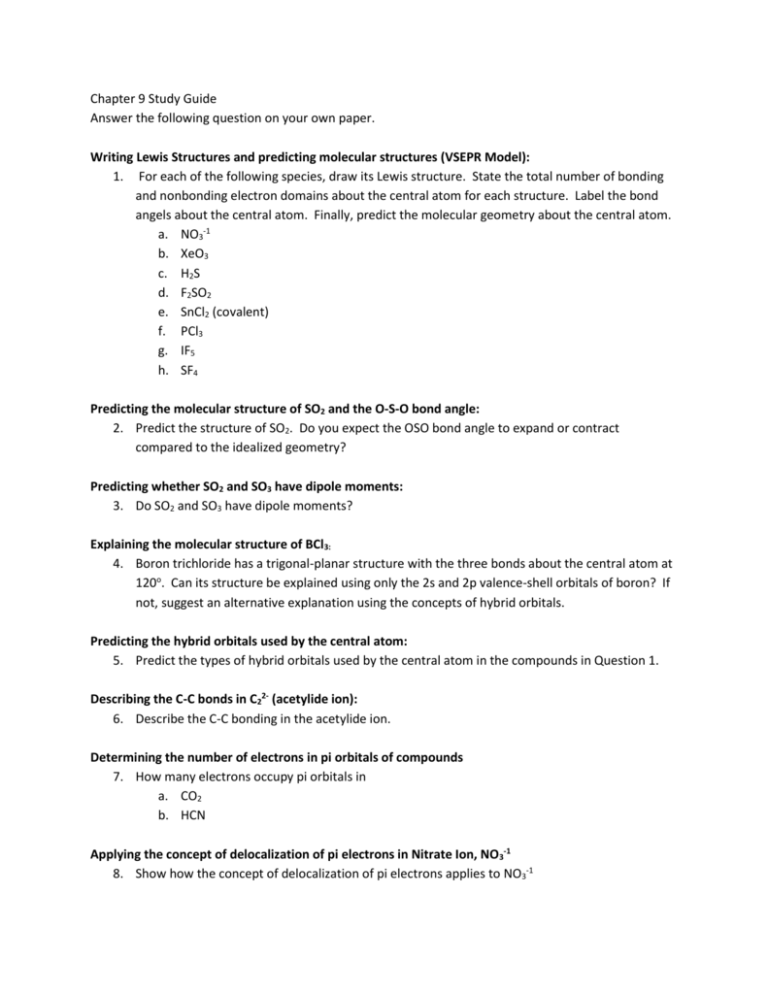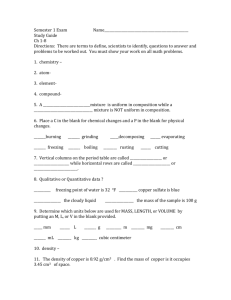Chapter 9 Study Guide for In
advertisement

Chapter 9 Study Guide Answer the following question on your own paper. Writing Lewis Structures and predicting molecular structures (VSEPR Model): 1. For each of the following species, draw its Lewis structure. State the total number of bonding and nonbonding electron domains about the central atom for each structure. Label the bond angels about the central atom. Finally, predict the molecular geometry about the central atom. a. NO3-1 b. XeO3 c. H2S d. F2SO2 e. SnCl2 (covalent) f. PCl3 g. IF5 h. SF4 Predicting the molecular structure of SO2 and the O-S-O bond angle: 2. Predict the structure of SO2. Do you expect the OSO bond angle to expand or contract compared to the idealized geometry? Predicting whether SO2 and SO3 have dipole moments: 3. Do SO2 and SO3 have dipole moments? Explaining the molecular structure of BCl3: 4. Boron trichloride has a trigonal-planar structure with the three bonds about the central atom at 120o. Can its structure be explained using only the 2s and 2p valence-shell orbitals of boron? If not, suggest an alternative explanation using the concepts of hybrid orbitals. Predicting the hybrid orbitals used by the central atom: 5. Predict the types of hybrid orbitals used by the central atom in the compounds in Question 1. Describing the C-C bonds in C22- (acetylide ion): 6. Describe the C-C bonding in the acetylide ion. Determining the number of electrons in pi orbitals of compounds 7. How many electrons occupy pi orbitals in a. CO2 b. HCN Applying the concept of delocalization of pi electrons in Nitrate Ion, NO3-1 8. Show how the concept of delocalization of pi electrons applies to NO3-1 Self-Test Questions: 1. Which of the following patterns of bonding and non-bonding electrons about a central atom show the octet rule? 2. Estimating the enthalpy of reaction using bonding energies requires an ability to analyze a chemical reaction to determine which bonds are broken and formed. From the following diagram determine which bonds, and how many of each, are broken and formed. 3. What are common possible molecular shapes for a molecule with the general formula AB3? Draw the three structures. 4. Draw the Lewis structures for the following molecules and predict their molecular structures and the types of hybrid orbitals used by the central atoms: a. b. c. d. e. 5. XeO4 PO4-3 TeF6 ICl2-1 SbF5 Draw the Lewis structures for CO, CO2, and CO3-2 and predict the trend in C-O bond distances. 6. Which of the following possess delocalized pi electrons? a. CH2Cl2 b. OCN-1 c. N2O 7. The molecules SF2, SF4, and SF6 are known. a. Draw the Lewis structure for each. b. Predict the structure of each. c. What type of hybrid atomic orbitals are used by each sulfur atom in bonding to fluorine atoms? d. Which are polar? e. Why can sulfur exhibit a variety of sulfur-fluorine compounds but oxygen does not?







